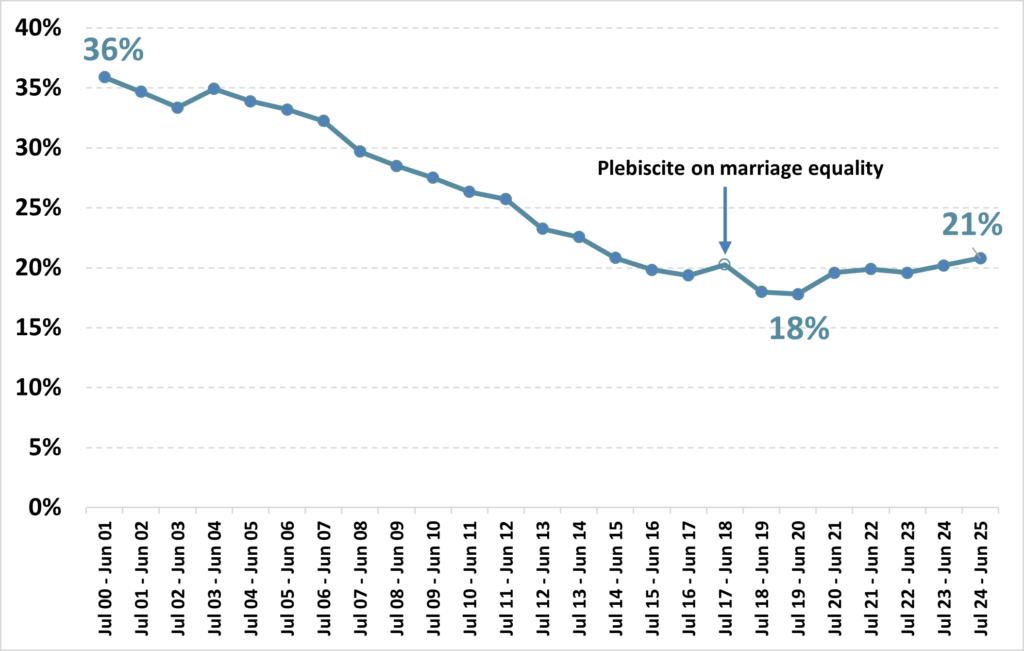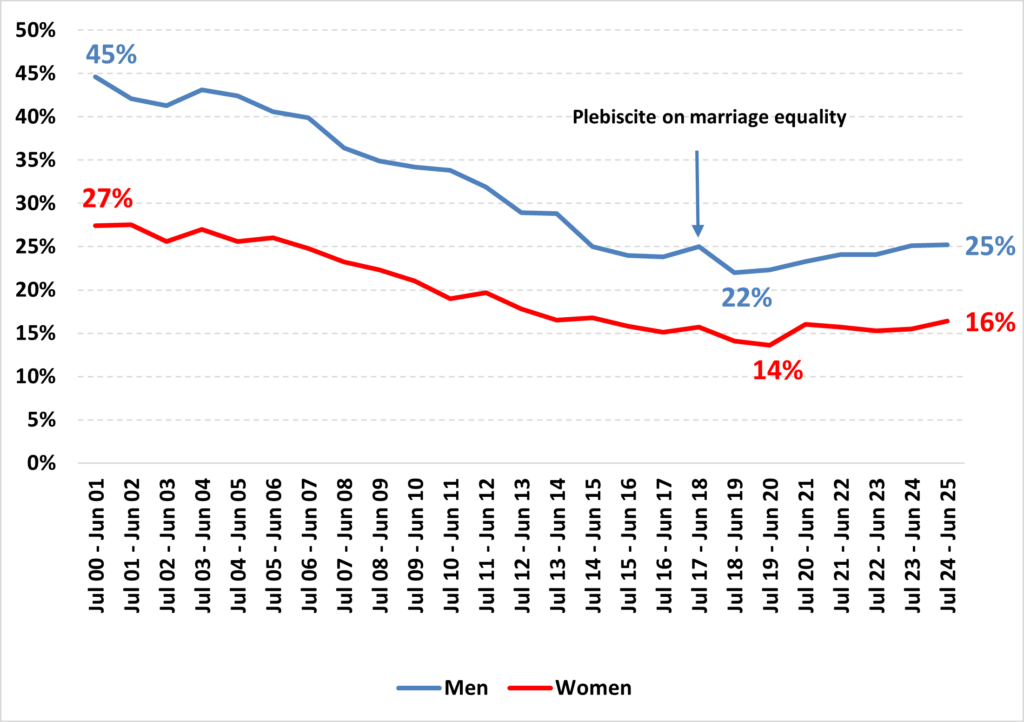21% of Australians believe homosexuality is immoral

Roy Morgan’s latest research highlights a quarter century of change, with two decades of declining homophobic views followed by a recent reversal. Since 2000, Roy Morgan has been monitoring Australians views on homosexuality, asking approximately 1,000 Australians each week (50,000 each year) whether they agree or disagree with the statement ‘I believe homosexuality is immoral’.
In 2000–01, 36% of Australians aged 14+ agreed with the statement 'I believe homosexuality is immoral,’ compared to 21% today, a decrease of 15% points over the past quarter century.
The data shows a steady decline for two decades: belief that homosexuality is immoral fell below 30% for the first time in 2008–09, and then under 20% by 2016–17 ahead of the national debate and legalisation of marriage equality in 2017.
During this period, there was a short-term increase in agreement in 2017–18, before homophobic sentiment reached a record low of 18% from July 2018 to June 2020. But in the years since, this downward trend has stalled, edging back up to 21% by 2024–25, marking the first sustained increase in over two decades.
% of Australian who Agree with the statement: ‘I believe homosexuality is immoral’

Source: Roy Morgan Single Source (Australia). Base: Australian, aged 14+ between July 2001 and June 2025, average interviews per year (n=55,739), total: (n=1,393,469).
Gender divide persists on attitudes towards homosexuality despite long-term decline
Analysing gender shows men are more likely to believe homosexuality is immoral (25%) than women (16%). In 2000–01, almost half of all men (45%) and just over a quarter of women (27%) agreed ‘homosexuality is immoral’. Over the next two decades, both women and men became significantly more accepting, with support for this sentiment falling to record lows by 2018–19 – just 14% of women and 22% of men.
Attitudes hardened slightly after the 2017–18 period (during the period of the same sex marriage plebiscite), with men in particular recording a small uptick in agreement with the statement.
By 2024–25, one in four men (25%) now agree that ‘homosexuality is immoral’, compared with 16% of women. This marks a modest increase for both sexes since 2021–22, reversing some of the progress made in the preceding decade.
% of Australian Men & Women who agree with the statement: ‘I believe homosexuality is immoral’

Source: Roy Morgan Single Source (Australia). Base: Australian, aged 14+ between July 2001 and June 2025, average interviews per year (n=55,739), total: (n=1,393,469).
Roy Morgan CEO Michele Levine says:

“In late August, former West Coast Eagles player Mitch Brown ‘came out’ and became the first current, or former, openly gay or bisexual male player in VFL/AFL history.
“Homophobic attitudes in Australia have fallen steadily over the past 25 years, down 15% points, from 36% in 2000–01 to 21% in 2024–25. Sentiment reached a historic low of 18% in 2018–20.
“However, over the past five years the downward trend has stalled, edging back up to 21% by 2024–25, marking the first sustained increase in over two decades.
“Women show greatest acceptance, with only 16% now viewing homosexuality as immoral, while one in four men (25%) still hold anti-gay views, showing progress but also a persistent gender gap.
“The extensive media attention surrounding Mitch Brown’s announcement regarding his sexuality highlights both the advances in acceptance over recent decades and the ongoing need to challenge lingering prejudice in sport and society.”
For comments or more information about Roy Morgan’s data please contact Andrew Calvert-Jones or Julian McCrann for more details.
Reports available for sale:
The latest Roy Morgan data is available on the Roy Morgan Online Store. It provides demographic breakdowns for Age, Sex, State, Region (Capital Cities/ Country), Generations, Lifecycle, Socio-Economic Scale, Work Status, Occupation, Home Ownership, Voting Intention, Roy Morgan Value Segments, Helix Personas, Media Consumption, and more.
Related Research:
About Roy Morgan
Roy Morgan is Australia’s largest independent Australian research company, with offices in each state, as well as in the U.S. and U.K. A full-service research organisation, Roy Morgan has over 80 years’ experience collecting objective, independent information on consumers.
Margin of Error
The margin of error to be allowed for in any estimate depends mainly on the number of interviews on which it is based. Margin of error gives indications of the likely range within which estimates would be 95% likely to fall, expressed as the number of percentage points above or below the actual estimate. Allowance for design effects (such as stratification and weighting) should be made as appropriate.
| Sample Size | Percentage Estimate |
| 40% – 60% | 25% or 75% | 10% or 90% | 5% or 95% | |
| 1,000 | ±3.0 | ±2.7 | ±1.9 | ±1.3 |
| 5,000 | ±1.4 | ±1.2 | ±0.8 | ±0.6 |
| 7,500 | ±1.1 | ±1.0 | ±0.7 | ±0.5 |
| 10,000 | ±1.0 | ±0.9 | ±0.6 | ±0.4 |
| 20,000 | ±0.7 | ±0.6 | ±0.4 | ±0.3 |
| 50,000 | ±0.4 | ±0.4 | ±0.3 | ±0.2 |



